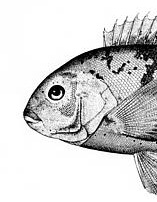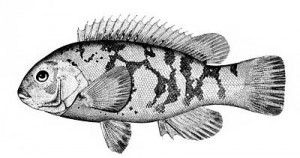If I were to submit a fish into a beauty contest, it would NOT be a Tautog. They are by far one of the most unattractive looking fish, but very good tasting. Their crooked teeth, fat lips and high forehead make them look like a star wars character. Many anglers express great frustration both trying to locate them as well as getting them on the line. Trying to find a good Tautog “Hole” is always a challenge and sometimes just a few feet can make all the difference in a successful or fruitless day. Fishing a good spot requires some talent as the jagged rocks and habit of tautag to swim back into their hiding places once hooked makes tautag fishing very challenging.
Tautog Fishing Facts
Tautog are sometimes referred to as blackfish due to their skin color. They generally have a white underbelly and the females sometimes have a white band that runs vertically up their bodies called a “saddle”. As mentioned above they have flat crooked teeth that are perfectly suited for smashing up shellfish or crustaceans which is their primary food source. They generally do not exceed 20lbs and most Tautog that are caught are under 20lbs. Large ones have been landed but rarely. In the far back on thier mouths they have what look like molars which also help to crush up shells of crabs or other hard bivalves. The larger Tautog are referred to white chins as when they grow larger thier chins turn white. Tautog are a popular sports-fish for spear-fisherman as they have attendacy to be very brave and do not scare away easily. They also are a school fish so if you can find a good fishing hole you will be pleasantly rewarded with an abundance of fish. They spawn in the early spring generally in deeper water away from inlets and bays.
How to Catch Tautog
Tautog fishing offers numerous challenges. The first challenge would be to locate them, in many Tautog fishing trips I have had success landing many fish while the boats just a few yards away were not catching anything. This is due to the fishes resistance to swim away from a nearby food source. If the Tautog are feeding around some underground structure they will not make an excursion away from it to bite on your clam worm that is floating just a few yards away. Once you do find the Tautog this offers the second challenge. As I just mentioned they prefer to swim near structure and often times will hide within rocks or sunken shipwrecks. This offers many opportunities to get snagged on rocks and other structure. Use the following rig while fishing for Tautag in order to have less of a chance of getting snagged on the bottom and places the bait right where the fish are located.
- The setup that I use when I Tautog fish is the typical three way rig with a slight modification. I generally fish with 15 to 20 lb test line with either a noose knot or perfection loop at the end of my line. I then attach a 2 to 3 ounce sinker to a few feet of lighter lb test line, either a 5 to 7 lb test line. I attach the lighter line to the noose knot. I some times use a three way swivel in place of knot, but either setup is effective. I then attach a Tautog hook to the noose knot at the end of my fishing line. Bait with crab or clam worm.
- The other rig that I use is a more standard setup. I simply attach a Tautog hook to the end of my 15 lb test line with a sinker a few feet above it. I do not send this rig all the way to the bottom however. I keep it a foot from the bottom in order to limit the snags on the structure below.
If I am fishing with crab I will split the crab in half, threading my hook through the crab the best way that I can. I generally use hooks that have a longer shank and shorter bend as the Tautog have smaller mouths. They would not be able to place a hook with a larger bend in its mouth.
Anchoring offers just as much of a challenge Tautog fishing then the actual fishing on certain days. Getting the boat to position itself right over the hole on the depth finder can be a challenge and it often takes me a few tries in order to get it right. They payoff of getting the right spot will be worth the struggles of the beginning of the trip. Fight the temptation to just settle on a spot that your think is “good enough”.
Fishing for Tautog by boat is generally much more effective than by shore. I have only tried to fish for Tautog from shore one time and found it to be very challenging as getting snagged on the bottom was becoming a real issue.
Also I do not recommend drifting while Tautog fishing as you will most likely get snagged on the bottom and go through most of your gear.
What is the Best Bait for Tautog Fishing
I have tried a variety of baits while Tautog fishing. Green crabs and Clam-worms seem to produce the best results for me. The best bait is always what they are naturally feeding on. It pays off to do some research and talk to the locals. I have heard that some anglers actually use lobster pieces in order to catch lobster. I honestly cannot see the sense of wasting a perfectly good piece of lobster to catch a tautog.
Where to catch Tautog
As mentioned above Tautog prefer structure of some kind in order to hide out from predators as well as be close to their natural food source. A good fish finder or depth finder is a requirement when fishing for Tautog. Look for holes or areas where there is a very rocky bottom. Near piling or other man-made structures are also popular spots. A sunken shipwreck is also a good location. Spend some time studying the underwater structure. I often times will make a few trips to just search for good tautog spots earlier in the season.
Tautog can be caught in waters from Nova Scotchia and as far south as Georgia. They have been known to make migrations up and down the south, but their migratory patters cover much fewer area than what striped bass. Over the last few years however their migrating patterns have differed due to the warmer and sometimes colder temperature changes that we have experienced lately.
If you know of an area where mussell beds are prevelant their is a good chance you will find black fish in this location.
When is the best time to catch Tautog
In the areas near Rhode Island Tautog can be caught in early April and May. Then in the Fall they can be caught from September through November. The season seems to last longer the further north you go and shorter the further south. This varies greatly from year to year however and it is important to pay close attention to the water temperatures. Always talk to the local bait shops and other fisherman to see what the current fishing conditions are.
The tide condition is important as well. I generally have more successful trips on incoming tides opposed to a slack or outgoing tide.


